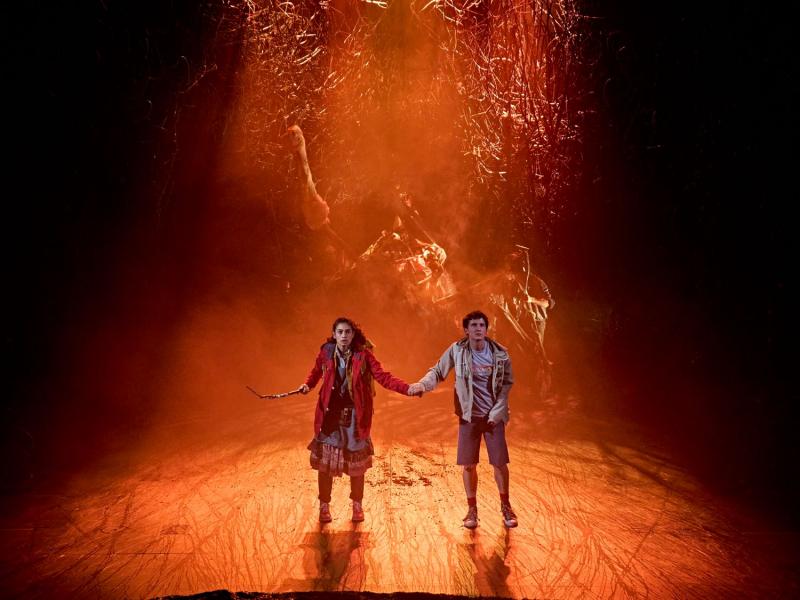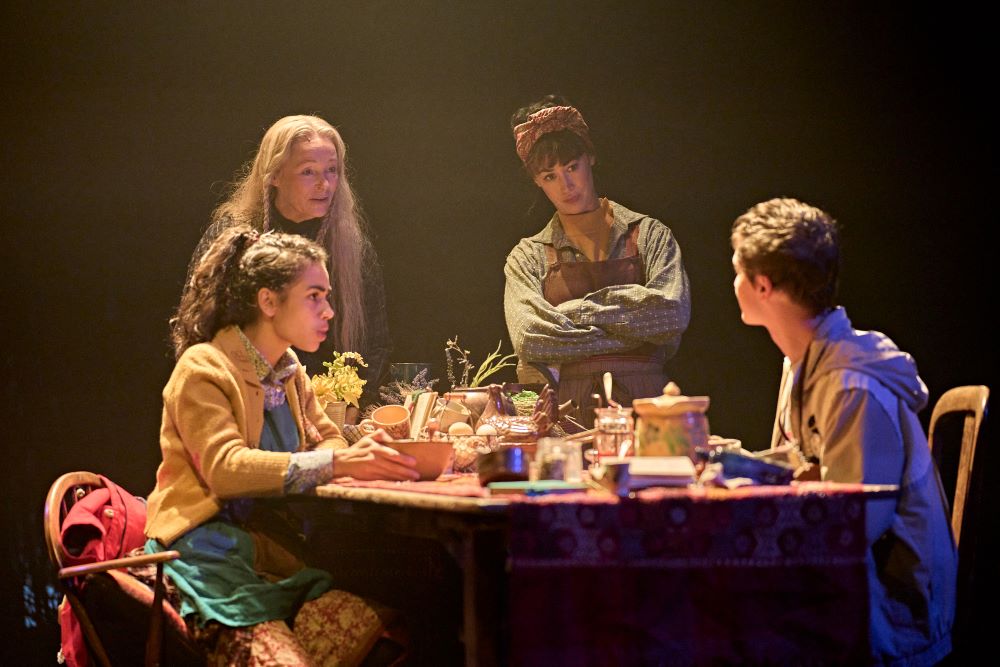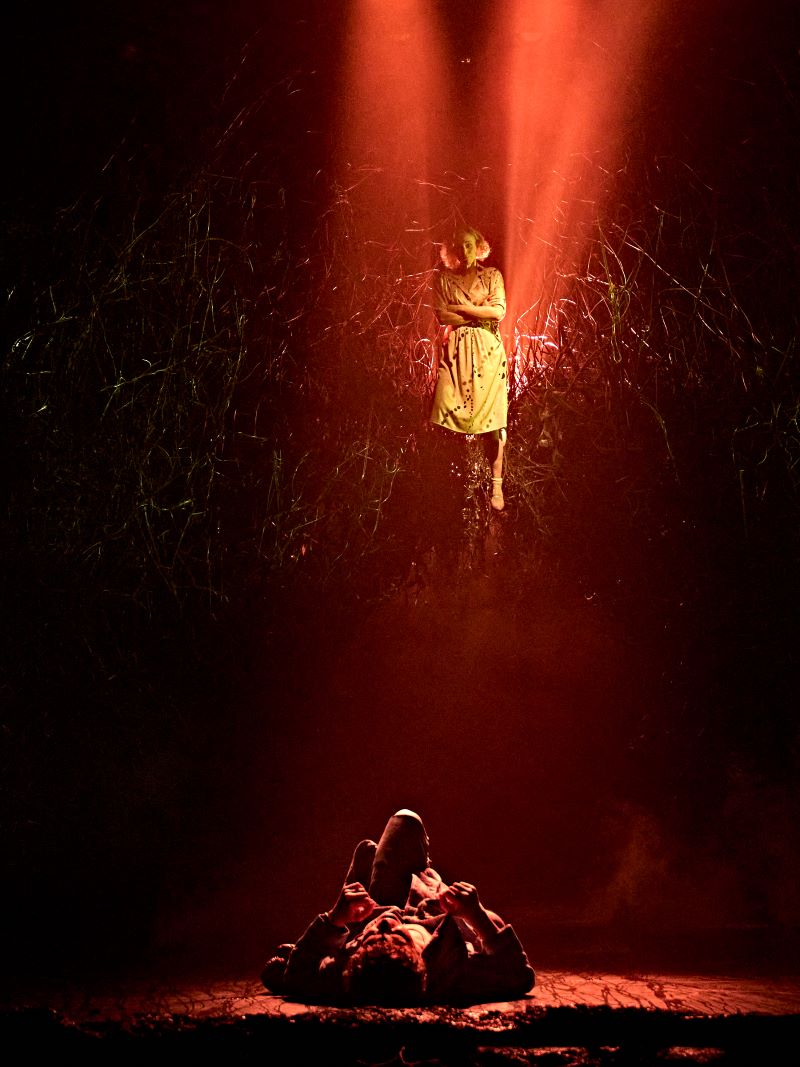The Ocean at the End of the Lane, Duke of York's Theatre review - pure theatrical magic | reviews, news & interviews
The Ocean at the End of the Lane, Duke of York's Theatre review - pure theatrical magic
The Ocean at the End of the Lane, Duke of York's Theatre review - pure theatrical magic
Spellbinding adaptation of Neil Gaiman's novel reminds us of the terror and beauty of childhood

This show has been a long time coming. Neil Gaiman had the first inklings of The Ocean at the End of the Lane when he was seven years old and living near a farm recorded in the Domesday Book. Several decades later, he wrote a short story for his wife, Amanda Palmer, “to tell her where I lived and who I was as a boy”, as he puts it in his programme notes.
That short story was developed into an award-winning novel; Joel Horwood’s adaptation opened at the Dorfman Theatre in late 2019, and was meant to transfer to the West End in early 2020. Now it’s back, and the spellbinding beauty of Katy Rudd’s staging is more than worth the wait.
We begin with death, and then more, and then more. A man (Nicolas Tennant) has returned to his childhood home for his father’s funeral, and stumbles from there down memory lane, back to his 12th birthday, when he discovered the body of his father’s lodger in the family car. The boy’s mother has also recently died, and his father is trying to keep everything together. An encounter with a charming little girl called Lettie Hempstock (Nia Towle) launches the Boy (James Bamford), who is never named, into a world of magic and peril.
In Steven Hoggett’s flowing choreography, Ocean shares DNA with The Curious Incident of the Dog in the Night-Time (which Hoggett, Rudd, and several cast members also worked on). Jherek Bischoff’s pulsing 80s score evokes Stranger Things, as does the show’s typeface. The emotional battery reminds us of A Monster Calls, another novel about a child’s grief transformed into a starkly beautiful production, for the Bristol Old Vic in 2017.  There are other familiar ingredients: a child protagonist who escapes reality through books; an annoying younger sister, played superbly here by Grace Hogg-Robinson; an evil stepmother figure by the name of Ursula Monkton (Laura Rogers). Still, Ocean is anything but predictable. It’s big and terrifying, but grounded in small details. Lettie takes the Boy home to her farmhouse to meet her mother Ginnie (Siubhan Harrison) and her grandmother (Penny Layden), who insists on being called Old Mrs Hempstock: “I was here first!”. Kind in a no-nonsense sort of way, they give him milk warm from the cow and pieces of sticky honeycomb, and warn him of the perils of wearing shorts. “Love a kneecap, badgers do.”
There are other familiar ingredients: a child protagonist who escapes reality through books; an annoying younger sister, played superbly here by Grace Hogg-Robinson; an evil stepmother figure by the name of Ursula Monkton (Laura Rogers). Still, Ocean is anything but predictable. It’s big and terrifying, but grounded in small details. Lettie takes the Boy home to her farmhouse to meet her mother Ginnie (Siubhan Harrison) and her grandmother (Penny Layden), who insists on being called Old Mrs Hempstock: “I was here first!”. Kind in a no-nonsense sort of way, they give him milk warm from the cow and pieces of sticky honeycomb, and warn him of the perils of wearing shorts. “Love a kneecap, badgers do.”
Like the book, the show is about memory, which is half imagination, according to Old Mrs Hempstock. Set designer Fly Davis outlines the doors and furniture of the Boy’s house in white light, as if his recollection stops at their edges. Paule Constable lights the Hempstocks’ kitchen in cosy oranges, camping lanterns suspended above the homely furniture; despite the fantastical danger they bring into his life, their world is a safe place for the Boy.
 Weirdly for a show with so many scary moments, the whole of Ocean feels safe – in a good way. Samuel Wyer’s puppets and Jamie Harrison’s illusions delight and confuse in equal measure. This is an ensemble piece, both onstage and off. The meticulously-timed dance of puppets, music, lights and actors makes you want to interview the stage managers.
Weirdly for a show with so many scary moments, the whole of Ocean feels safe – in a good way. Samuel Wyer’s puppets and Jamie Harrison’s illusions delight and confuse in equal measure. This is an ensemble piece, both onstage and off. The meticulously-timed dance of puppets, music, lights and actors makes you want to interview the stage managers.
The most important thing about adaptation is that it’s not rehashing the original medium beat for beat – it’s getting it to make sense in the new form. Horwood has recreated the dreamlike wonderment of Gaiman’s novel, using theatrical rather than literary tricks. Lettie asks the Boy if he wants to come over for pancakes; the Boy hesitates, and the ensemble members moving the pieces of the Hempstock kitchen into place look to him. It’s only when he says yes that the furniture is positioned.
No other production I’ve seen has captured the experience of childhood, the terror and the beauty – not what actually happened, but what it felt like (which is also what adaptation is about). That’s what Gaiman was trying to show his wife in his short story, and it’s what everyone who made Ocean shows us.
rating
Explore topics
Share this article
The future of Arts Journalism
You can stop theartsdesk.com closing!
We urgently need financing to survive. Our fundraising drive has thus far raised £49,000 but we need to reach £100,000 or we will be forced to close. Please contribute here: https://gofund.me/c3f6033d
And if you can forward this information to anyone who might assist, we’d be grateful.

Subscribe to theartsdesk.com
Thank you for continuing to read our work on theartsdesk.com. For unlimited access to every article in its entirety, including our archive of more than 15,000 pieces, we're asking for £5 per month or £40 per year. We feel it's a very good deal, and hope you do too.
To take a subscription now simply click here.
And if you're looking for that extra gift for a friend or family member, why not treat them to a theartsdesk.com gift subscription?
more Theatre
 Hamlet, National Theatre review - turning tragedy to comedy is no joke
Hiran Abeyeskera’s childlike prince falls flat in a mixed production
Hamlet, National Theatre review - turning tragedy to comedy is no joke
Hiran Abeyeskera’s childlike prince falls flat in a mixed production
 Lee, Park Theatre review - Lee Krasner looks back on her life as an artist
Informative and interesting, the play's format limits its potential
Lee, Park Theatre review - Lee Krasner looks back on her life as an artist
Informative and interesting, the play's format limits its potential
 Measure for Measure, RSC, Stratford review - 'problem play' has no problem with relevance
Shakespeare, in this adaptation, is at his most perceptive
Measure for Measure, RSC, Stratford review - 'problem play' has no problem with relevance
Shakespeare, in this adaptation, is at his most perceptive
 The Importance of Being Earnest, Noël Coward Theatre review - dazzling and delightful queer fest
West End transfer of National Theatre hit stars Stephen Fry and Olly Alexander
The Importance of Being Earnest, Noël Coward Theatre review - dazzling and delightful queer fest
West End transfer of National Theatre hit stars Stephen Fry and Olly Alexander
 Get Down Tonight, Charing Cross Theatre review - glitz and hits from the 70s
If you love the songs of KC and the Sunshine Band, Please Do Go!
Get Down Tonight, Charing Cross Theatre review - glitz and hits from the 70s
If you love the songs of KC and the Sunshine Band, Please Do Go!
 Punch, Apollo Theatre review - powerful play about the strength of redemption
James Graham's play transfixes the audience at every stage
Punch, Apollo Theatre review - powerful play about the strength of redemption
James Graham's play transfixes the audience at every stage
 The Billionaire Inside Your Head, Hampstead Theatre review - a map of a man with OCD
Will Lord's promising debut burdens a fine cast with too much dialogue
The Billionaire Inside Your Head, Hampstead Theatre review - a map of a man with OCD
Will Lord's promising debut burdens a fine cast with too much dialogue
 50 First Dates: The Musical, The Other Palace review - romcom turned musical
Date movie about repeating dates inspires date musical
50 First Dates: The Musical, The Other Palace review - romcom turned musical
Date movie about repeating dates inspires date musical
 Bacchae, National Theatre review - cheeky, uneven version of Euripides' tragedy
Indhu Rubasingham's tenure gets off to a bold, comic start
Bacchae, National Theatre review - cheeky, uneven version of Euripides' tragedy
Indhu Rubasingham's tenure gets off to a bold, comic start
 The Harder They Come, Stratford East review - still packs a punch, half a century on
Natey Jones and Madeline Charlemagne lead a perfectly realised adaptation of the seminal movie
The Harder They Come, Stratford East review - still packs a punch, half a century on
Natey Jones and Madeline Charlemagne lead a perfectly realised adaptation of the seminal movie

Add comment